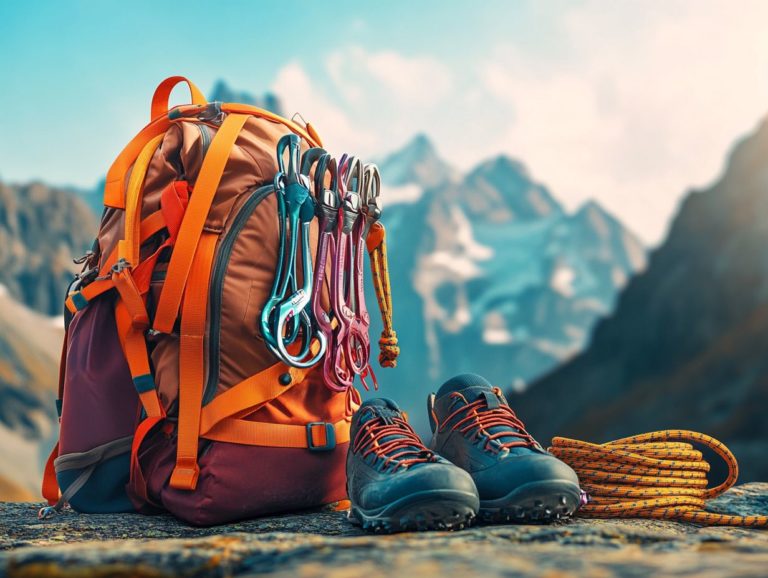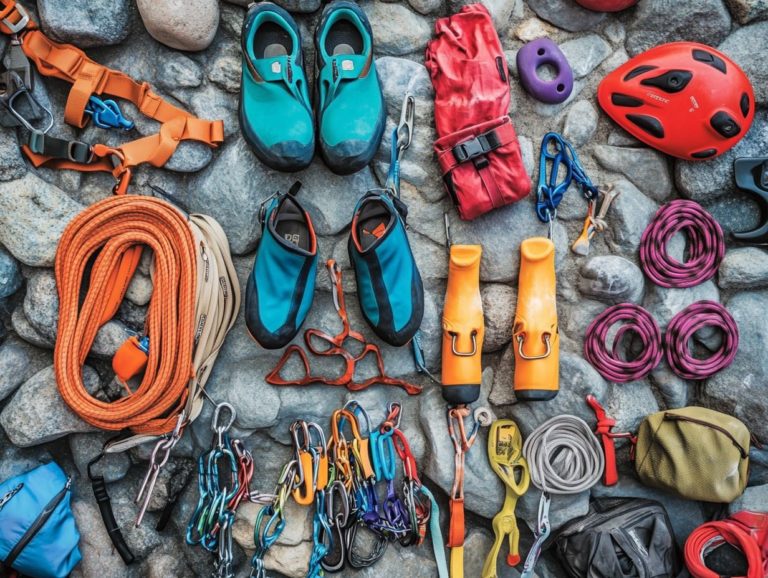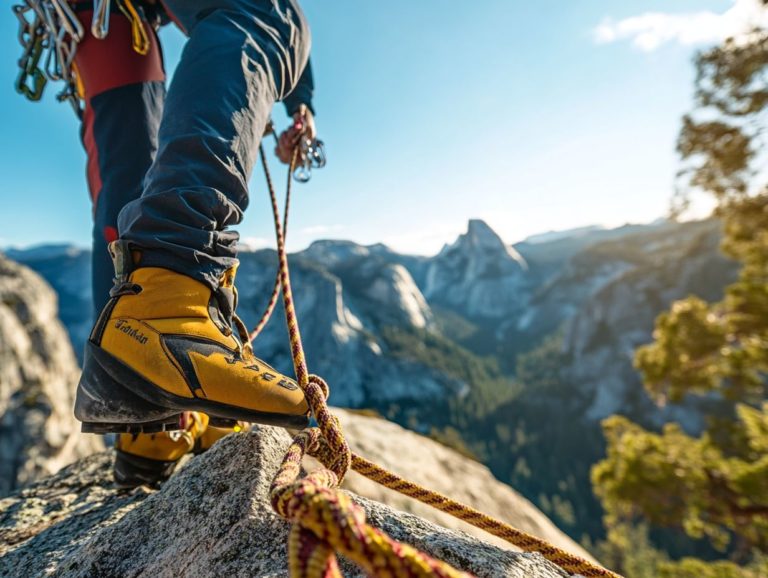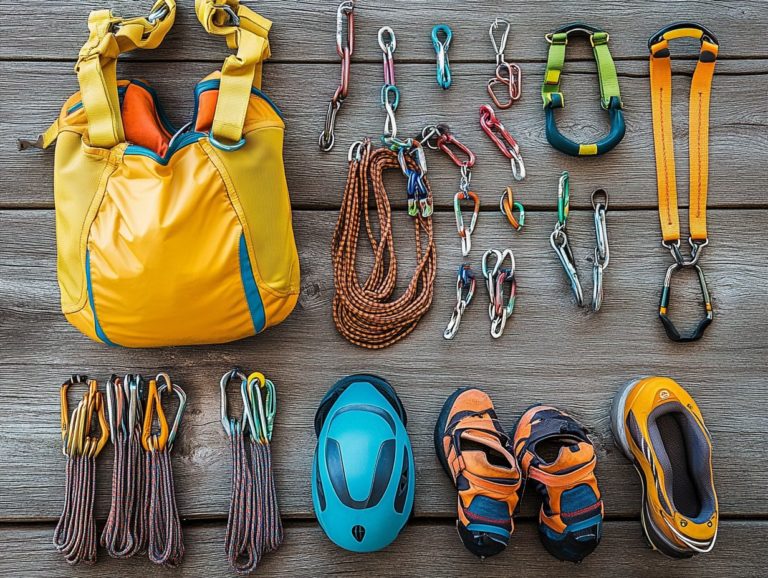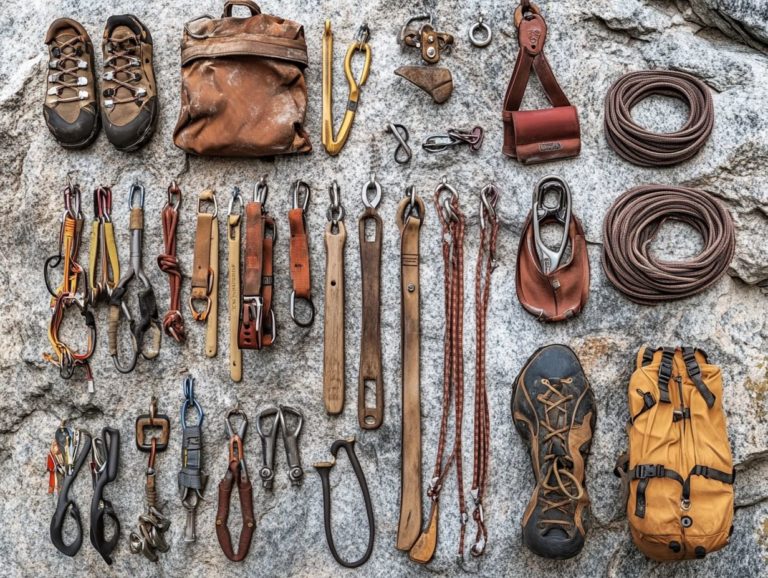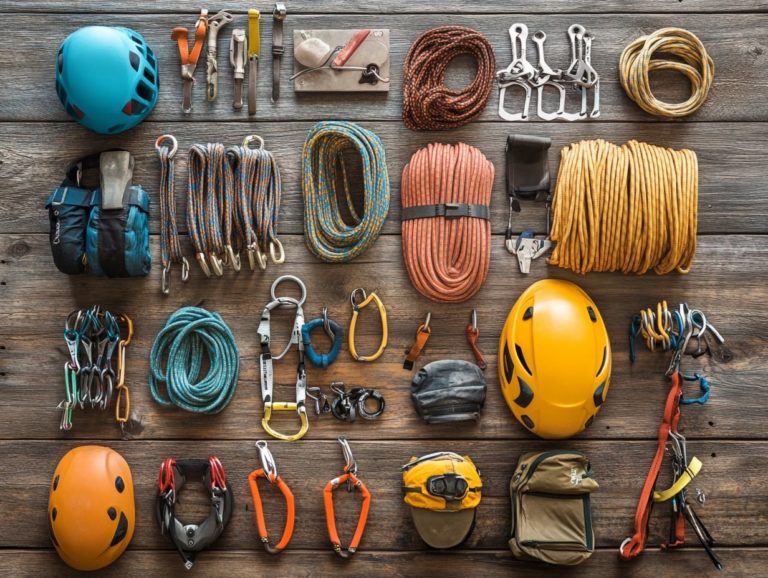The Benefits of Using a Climbing Sling
Climbing slings are must-haves for every climber! They enhance your safety, efficiency, and versatility across various climbing scenarios.
This guide explores the different types of climbing slings, their materials, and specific uses. Discover the benefits these tools offer, from increased safety to improved efficiency.
Learn how to choose the perfect sling to meet your needs. Also, find tips for maintaining your gear to ensure it lasts.
Whether you re new to climbing or have years of experience, this guide will help you make informed decisions about your climbing slings.
Contents
- Key Takeaways:
- Types of Climbing Slings
- Benefits of Using Climbing Slings
- How to Choose the Right Climbing Sling
- Caring for Your Climbing Sling
- Frequently Asked Questions
- Every climber needs reliable gear here s why climbing slings are essential!
- How does using a climbing sling improve safety while rock climbing?
- What makes climbing slings versatile and useful for climbers?
- Are climbing slings easy to use for both beginners and experienced climbers?
- Climbing slings are also lightweight and compact!
- Can climbing slings be used in other outdoor activities besides rock climbing?
Key Takeaways:
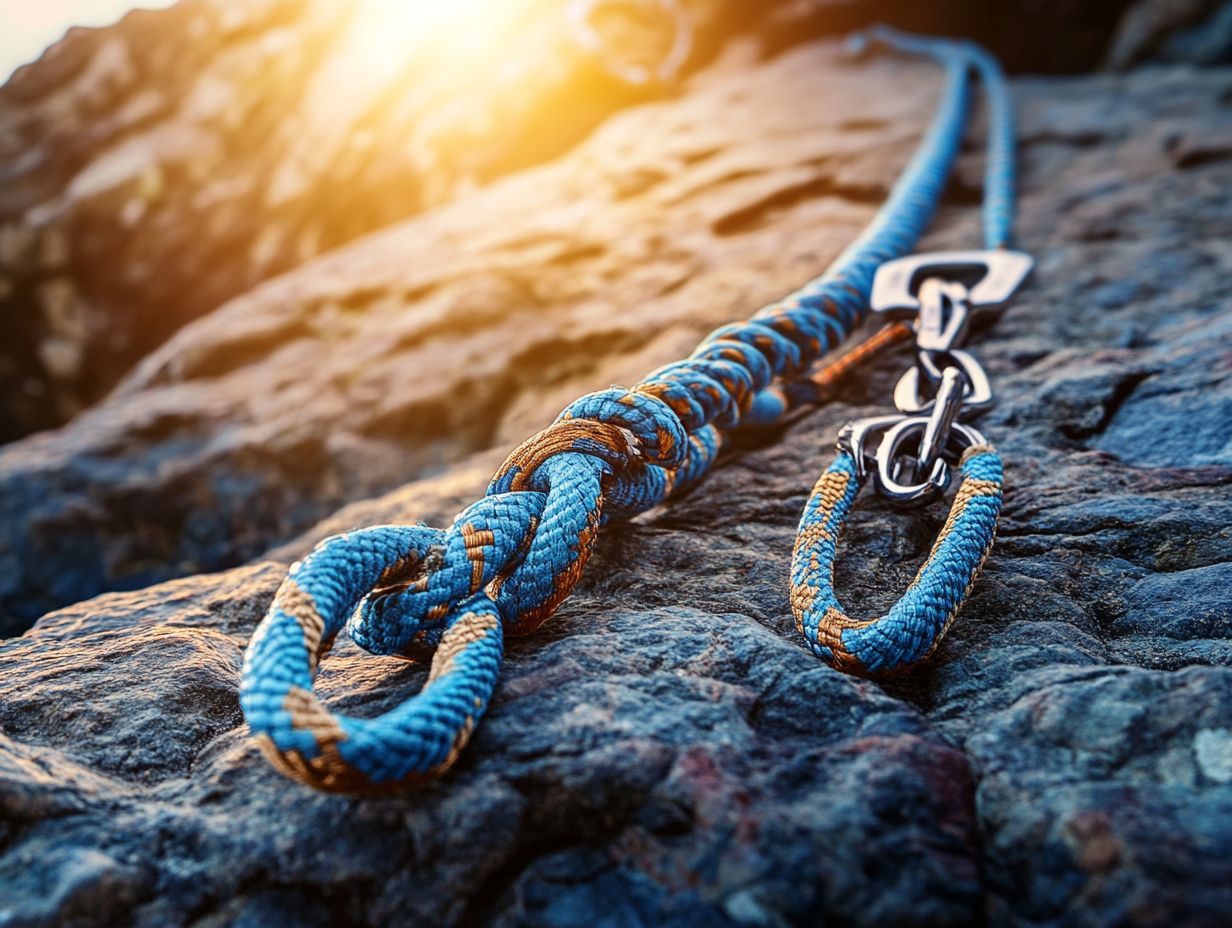
- Climbing slings provide a secure connection between you and the anchor point, enhancing safety and efficiency.
- These versatile tools are essential for any climber tackling different routes and challenges.
- Proper care and maintenance are crucial for longevity. Consider material, length, strength, and weight ratio when choosing the right sling.
What are Climbing Slings?
Climbing slings are essential tools for safety and support. They help you ascend and descend challenging terrains with confidence.
Made from materials like nylon and Dyneema, these slings are vital parts of your climbing gear. They can be used for anchoring, rappelling, or connecting to protection points.
The material you choose impacts strength, weight ratio, and durability. These factors are essential for optimal performance in different conditions.
Climbing slings create a secure connection between components of your climbing system, such as carabiners and protection gear. Picking the right sling material directly affects your safety and efficiency during climbs.
Lighter options improve your maneuverability, while stronger materials give peace of mind with heavy loads. Properly integrating slings into your setup boosts performance and allows confident descents.
Techniques like rappelling become easier, reducing risks associated with falls or equipment failure.
Types of Climbing Slings
Understanding the various types of climbing slings is essential for optimizing your gear choices. This knowledge will elevate your safety.
From flat webbing slings to hybrid options and threaded loops, each type serves specific functions. They adapt to your climbing situations whether tackling multi-pitch ascents in the Bugaboos or rappelling down the cliffs of Yosemite.
Your choice between nylon and Dyneema greatly influences the slings’ strength, durability, and weight ratio. These are critical factors every climber should consider.
Different Materials and Uses
The materials for climbing slings, such as nylon and Dyneema, significantly impact performance and durability. They determine suitability for various climbing scenarios.
Each material has unique qualities influencing your choices based on your ascent type. For instance, nylon has great abrasion resistance, making it ideal for traditional climbs.
However, under extreme conditions, nylon can absorb water, increasing weight and reducing durability. Dyneema, on the other hand, is lightweight, perfect for high-altitude climbs where every ounce counts.
But remember, Dyneema lacks the same cut resistance as nylon. This difference means you must carefully assess your specific climbing scenarios to choose wisely.
Benefits of Using Climbing Slings
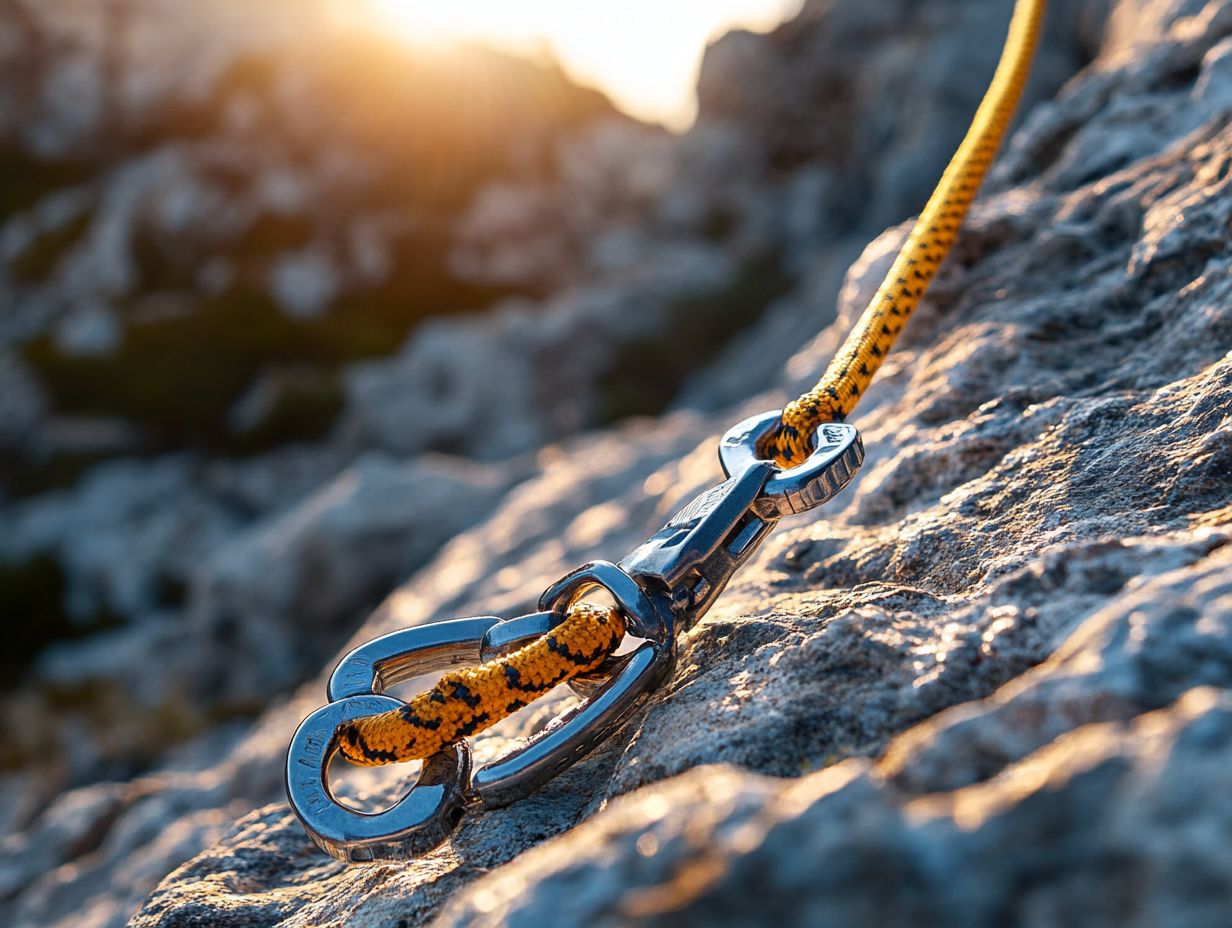
Climbing slings are your ticket to a safer and more efficient climbing experience. No matter your skill level, these essential tools can elevate your adventure! Climbing slings present a multitude of benefits that elevate safety, efficiency, and versatility. These important links act as vital connectors, delivering reliable protection and support in a variety of climbing scenarios, whether you’re tackling multi-pitch climbs in Red Rocks or executing technical ascents in Yosemite.
Their adaptability gives you the power to employ various techniques, allowing you to navigate challenging terrains safely while enhancing performance and minimizing risks.
Enhanced Safety and Efficiency
Enhanced safety and efficiency are key reasons you should rely on slings during your ascents and descents. By providing secure anchors and backup points, climbing slings significantly reduce the risk of injury, offering vital protection against falls. Their lightweight design ensures you can navigate challenging terrains with ease.
Employing techniques such as proper knot tying and backup systems further elevates your climbing experience, giving you the power to concentrate on your routes with confidence.
Understanding different knot types is essential for using slings effectively, ensuring they remain secure throughout your climb. Mastering knots like the figure-eight and bowline is crucial, as both are renowned for their reliability.
Incorporating backup slings can be a game changer. Positioning them to catch potential falls provides an extra layer of safety. Regularly checking the integrity of your slings and practicing quick adjustments enhances your overall movement efficiency.
Paying attention to detail strengthens your safety and builds trust in your climbing gear, allowing you to fully embrace the adventure that lies ahead.
Versatility in Various Climbing Situations
The versatility of climbing slings makes them critical in various climbing scenarios, from alpine expeditions to multi-pitch climbs. Depending on your route’s specific needs, you can utilize different types of slings be it for anchoring, rappelling, or securing gear allowing you to adapt seamlessly to the challenges posed by the terrain.
This adaptability ensures you’re well-equipped to handle varying conditions, maximizing both your safety and performance.
In alpine settings, for instance, the durability of nylon slings proves crucial for creating bombproof anchors on rocky surfaces where stability is key. Meanwhile, in multi-pitch situations, shorter slings are often your go-to for direct attachment to carabiners, enabling more efficient transitions between climbs.
Each environment showcases the unique roles that slings play. Whether it s a quick draw on a vertical face or a loop to secure gear in a crevasse, their versatility gives you the power to maneuver safely and effectively.
This multifaceted utility reinforces the essential role slings hold in optimizing your climbing strategies across diverse terrains.
How to Choose the Right Climbing Sling
Selecting the perfect climbing sling is a pivotal decision that will greatly influence your safety and performance on the rock face. Consider various factors like the type of material be it nylon or Dyneema as well as the sling s weight ratio, strength, and intended application.
Whether you’re gearing up for alpine climbing, tackling multi-pitch routes, or simply seeking a reliable backup, grasping these elements will give you the power to choose the most suitable gear tailored to your specific needs.
Factors to Consider
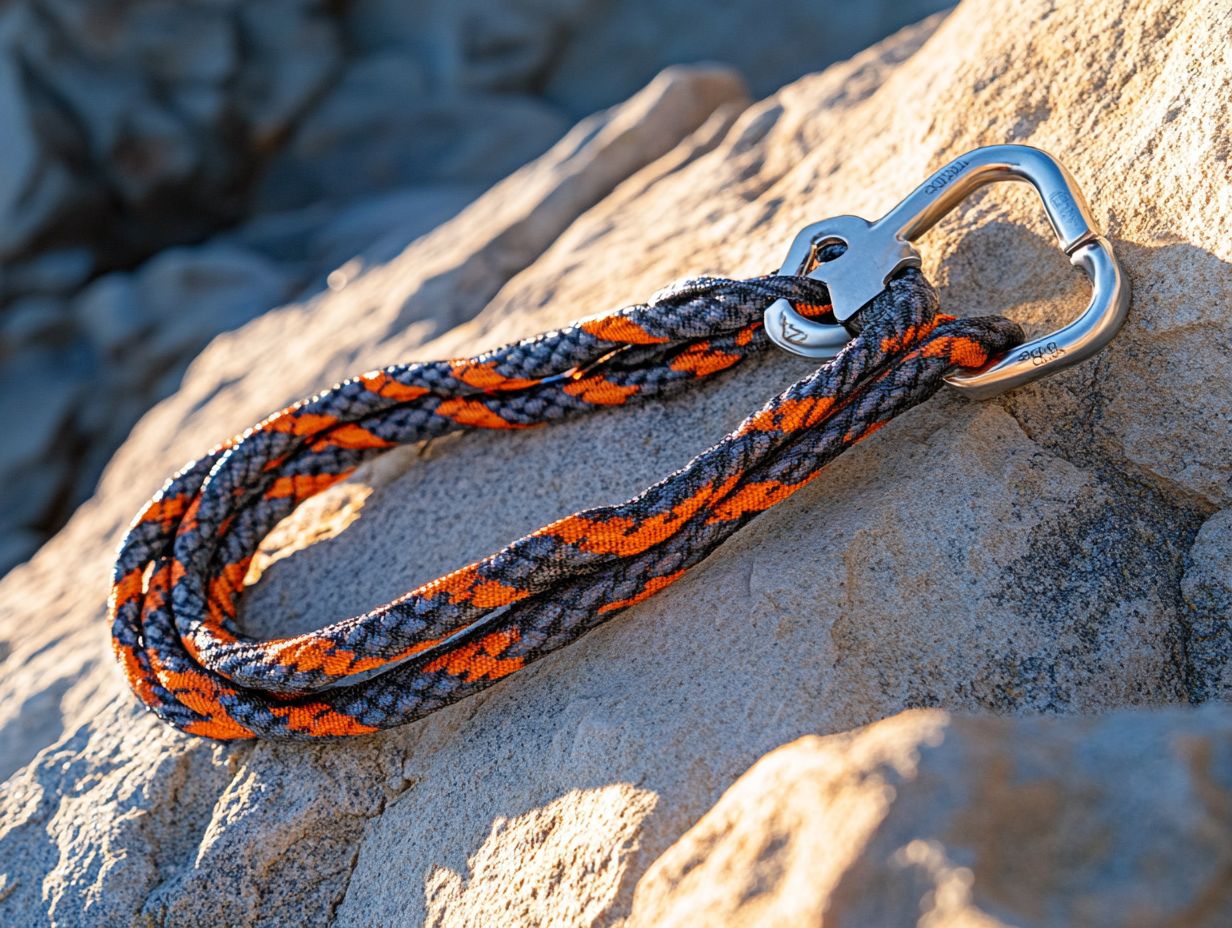
When you’re selecting a climbing sling, there are several key factors to consider to ensure both optimal performance and safety. Think about the material nylon offers outstanding durability, while Dyneema brings impressive lightweight strength to the table.
You’ll also want to pay attention to the sling’s length and width, as these dimensions can greatly affect its versatility across various applications. Understanding these nuances means you can make informed choices that cater to your specific climbing needs.
The material you choose doesn t just influence the overall weight of the sling; it also affects its abrasion resistance and strength-to-weight ratio, which refers to how strong the sling is compared to its weight. Length matters, too; longer slings might be essential for certain placements, while shorter ones can enhance stability during traditional climbs.
Additionally, the width of the sling impacts how easily you can handle it and the comfort level when tying knots.
Finally, consider the intended use whether it s for anchoring, extending gear placements, or setting up belays as this can further refine your selection process. Each choice you make plays a crucial role in enhancing your overall safety and efficiency on the climb.
Caring for Your Climbing Sling
Proper care and maintenance of your climbing slings are essential for ensuring their longevity and reliability when you’re out on the rock face. You should make it a habit to regularly inspect your slings for any signs of wear, UV damage, or abrasion.
Cleaning them according to the manufacturer’s recommendations will help maintain their durability and strength. By taking these steps, you not only extend the life of your gear but also enhance your safety during climbing adventures.
Tips for Maintenance and Longevity
To ensure the longevity and effectiveness of your climbing slings, it s essential to adopt regular maintenance routines that include thorough inspections and proper cleaning techniques. You should check for UV damage, abrasions, and frays to spot any potential weaknesses that could compromise your safety.
Make it a habit to inspect your slings before each climbing session, paying special attention to any signs of wear, discoloration, or abrasion damage. In terms of cleaning, tackle slings that have been exposed to dirt, sweat, or saltwater by hand washing them in lukewarm water with mild soap, and then let them air dry away from direct sunlight.
Proper storage is equally important. Keep your slings in a cool, dry place to preserve the integrity of the webbing and steer clear of sharp objects that could cause cuts. By incorporating these maintenance tips into your routine, you can significantly extend the life of your gear, ensuring your safety and confidence on every ascent.
Final Thoughts and Recommendations
Climbing slings are essential tools that significantly enhance both your safety and efficiency as you navigate various terrains and challenges. Get ready to elevate your climbing experience!
These versatile pieces of equipment serve multiple purposes, from connecting you to anchors to providing crucial security during your descents. Understanding the different types of slings available such as static and dynamic options that provide excellent energy absorption for falls allows you to choose the ones that best suit your specific climbing needs.
Regularly inspecting your slings for wear and tear is crucial to maintaining their integrity, as even minor damage can lead to serious accidents. You should also familiarize yourself with best practices for usage, including proper knot tying and weight distribution.
Utilizing resources like climbing forums, gear review sites, and instructional videos can further deepen your knowledge. Ultimately, by prioritizing safety through informed choices in climbing slings, you cultivate a more enjoyable and secure climbing experience.
Frequently Asked Questions
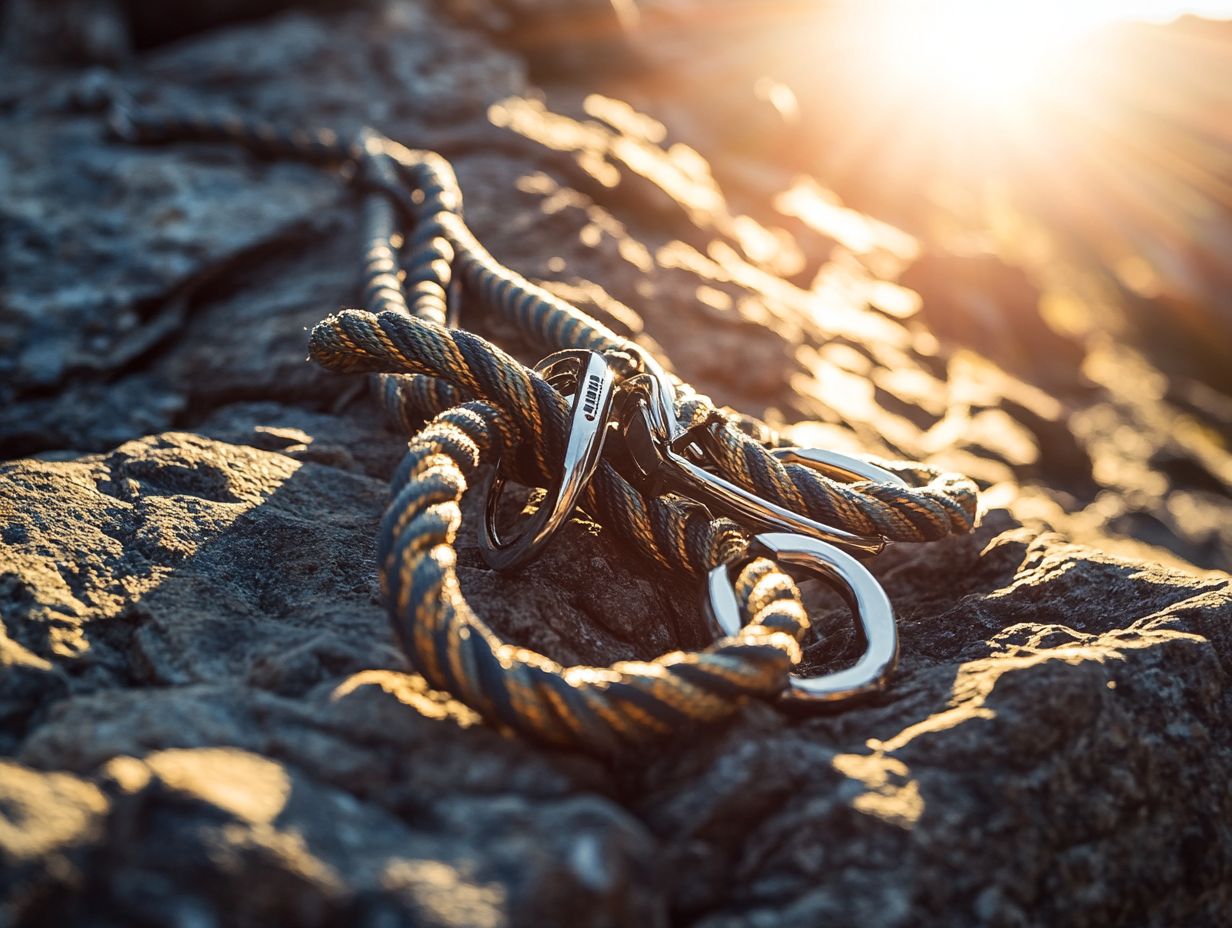
In this section, we invite you to learn more about climbing slings and their usage through some frequently asked questions.
Every climber needs reliable gear here s why climbing slings are essential!
A climbing sling is a piece of equipment used in rock climbing to create anchor points or extend protection. Its benefits include safety, versatility, and ease of use.
How does using a climbing sling improve safety while rock climbing?
Climbing slings create a strong connection between a climber and their gear, like metal loops used for securing climbing ropes, known as carabiners, and anchors. This connection reduces the risk of falls and enhances security when navigating tough sections of a climb.
What makes climbing slings versatile and useful for climbers?
Climbing slings come in various lengths and materials, allowing for customization based on the climb type and personal preferences. They serve multiple purposes, including creating anchor points, extending protection, and even acting as a makeshift rope in emergencies.
Are climbing slings easy to use for both beginners and experienced climbers?
Yes! Climbing slings are user-friendly and accessible for climbers at all levels. They require minimal training and can be used in various situations, making them a valuable addition to any climber’s gear.
Climbing slings are also lightweight and compact!
Particularly made from materials like Spectra and Aramid, they are easy to carry and transport while climbing. Their long lifespan and ability to withstand harsh conditions make them a great investment for climbers.
Can climbing slings be used in other outdoor activities besides rock climbing?
Absolutely! Climbing slings are useful in activities like mountaineering, canyoneering, and even setting up hammocks or tarps while camping. Their strength and versatility make them invaluable for various outdoor pursuits.

